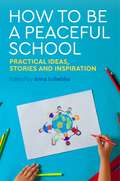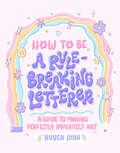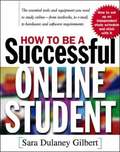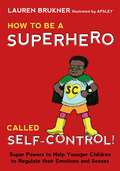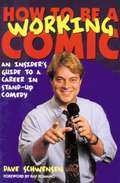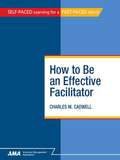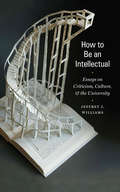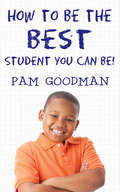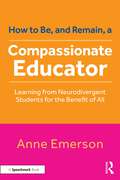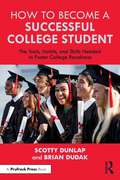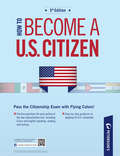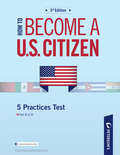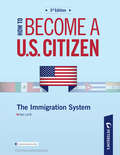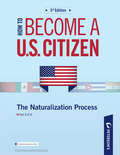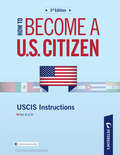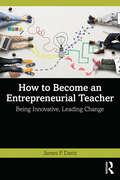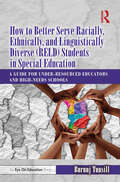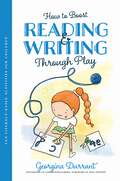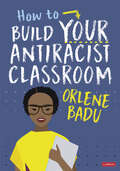- Table View
- List View
How to Be a Peaceful School: Practical Ideas, Stories and Inspiration
by Laura Roberts David Holmes Sue Webb Anna Lubelska Pali Nahal Jackie Zammit Helen Floyd Christine Easom Felicity Robinson Thérèse Hoyle Wendy Phillips Cardinal Newman Coventry Moira Thompson Isabel CartwrightPeace is needed now more than ever in schools, by pupils and teachers alike. This inspiring guide provides primary, secondary and special schools with practical methods to improve pupil and teacher wellbeing, combat bullying, and promote peace both inside and outside the school gates. The founder of the Peaceful Schools Movement, Anna Lubelska, has brought together ideas and stories from teachers and charity workers to present a simple four step system for promoting positive peace in individuals, relationships, the school community and the world. It covers how to reduce stress, promote positive mental health, resolve conflict, nurture the potential of each individual, and encourage children to develop peacemaking skills and values. This holistic resource is equally beneficial for children and staff, and transforms school environments for the better.
How to Be a Rule-Breaking Letterer: A Guide to Making Perfectly Imperfect Art
by Huyen DinhBreak the rules, embrace imperfection, and express your unique self through lettering art!This book is for anyone who's felt the pressure of perfection. As a schoolgirl in Vietnam and later in online lettering classes, Huyen Dinh was always told to perfect her penmanship. Instead, she started embracing her own imperfect style—with squiggly lines, cheeky messages, and pastel colors.In this upbeat guidebook, Dinh walks you through the basic rules of lettering and then teaches you how to break them in clever and creative ways. She shares challenges and triumphs from her own artistic journey and offers inspiration as well as technical tips. You can use your new lettering skills to tell your personal story, support a cause you care about, or decorate your tote bags and sneakers! Fully illustrated in Dinh's signature pastel palette, this book is the perfect companion for any aspiring creative.EVERYTHING YOU NEED IN ONE BOOK: This fresh and fun guide includes: Affirmations for a positive mindsetLettering language 101A step-by-step guide from brainstorming to finished artInspiration for telling your story through letteringFun DIY projects with how-to instructionsAnd much moreMAKES LETTERING FUN: No need to sweat over creating technically perfect calligraphy. Instead, let this guidebook infuse your creative projects with fun. Lettering is a chance to explore your personal style and share your passions with the world. EMPOWERING MESSAGE: By sharing her own story, Dinh offers inspiration for anyone who dreams of a creative career, especially other young Asian American women. This is an approachable and inclusive handbook for pursuing your artistic goals. RISING STAR: Huyen Dinh's refreshing honesty and irresistible illustration style have resonated with thousands of fans online. Her lettering art has graced murals, sweatshirts, magazine covers, and more. With this book, she welcomes anyone to join her in creating perfectly imperfect lettering.Perfect for:Letterers, artists, and illustrators looking for a fun and practical resourceStudents of all ages looking for a creative outletCasual creatives and hobbyists who love hand lettering, drawing with letters, and font, alphabet, and script designFashionistas who want to add personal flair to their accessoriesEngaged couples doing hand-lettered DIY wedding invitesPinterest addicts and bullet journaling enthusiasts seeking new letter design ideas and inspiration
How to Be a Successful Online Student
by Sara Dulaney GilbertAccording to the National Center for Education Statistics more than 85% of public universities offer non-residential long-distance learning and courses, degrees, or career credentials.
How to Be a Successful Student: 20 Study Habits Based on the Science of Learning
by Richard E. MayerHow to Be a Successful Student is a clear, concise, evidence-based guide to the habits that are scientifically proven to help people learn. Acclaimed educational psychologist Richard Mayer distils cutting edge research to focus on the 20 best study habits for college students, including habits for motivating yourself to learn, managing your learning environment, and effectively applying learning strategies. This accessible, practical book covers all three areas with evidence-based, approachable suggestions to help you become a successful student by developing effective study habits and rejecting ineffective ones.
How to Be a Superhero Called Self-Control!: Super Powers to Help Younger Children to Regulate their Emotions and Senses
by Apsley Lauren BruknerMeet Self-Control, a superhero who wants to teach young children his super powers of self-control! Anxiety, frustration, anger, and other difficult feelings won't stand a chance against their new-found powers. Self-Control teaches children with emotional and sensory regulation difficulties aged approximately 4-7 how to calm themselves using self-massage, deep pressure, breathing exercises, and activities such as making an imaginary list and finding their own peaceful place. This illustrated book also features an appendix with photocopiable super power charts, reinforcers, and reminder tools to ensure that parents, teachers, and other professionals can support children in upholding superhero strategies even after the book has been read.
How to Be a Working Comic: An Insider's Guide to a Career in Stand-up Comedy
by Dave SchwensenThis funny book about being funny aims to show how aspiring comedians can develop a presentation style, market their act and contact agents. It contains interviews with 16 famous stand-up comics including: Jeff Foxworthy, Drew Carey, Carrot Top and others.
How to Be an Effective Facilitator
by Charles M. CadwellHow to keep a person or team on track and work well with diverse personalities. By definition, a facilitator is a person who makes things easy. But if you sometimes find the role to be tough—mainly because you're a manager, not a professional facilitator—this targeted book provides all the help you need. It teaches you the skills needed to keep a person, group, or team on track, and it shows you how to work well with diverse personalities. Designed for general managers whose time is at a premium, the book presents a six-step process and tools that you can apply in any situation—whether you're facilitating a short-term problem-solving session or a multi-year strategic planning project. You will learn how to: • Build commitment and foster a "we" approach • Develop effective, time-saving agendas • Deal with equipment and logistics, such as room setup and flip chart techniques • Utilize different types of questioning techniques • Become an active listener • Give better feedback • Use tools such as brainstorming and storyboarding • Avoid groupthink
How to Be an Intellectual: Essays on Criticism, Culture, and the University
by Jeffrey J. WilliamsOver the past decade, Jeffrey J. Williams has been one of the most perceptive observers of contemporary literary and cultural studies. He has also been a shrewd analyst of the state of American higher education. How to Be an Intellectual brings together noted and new essays and exemplifies Williams’s effort to bring criticism to a wider publicHow to Be an Intellectual profiles a number of critics, drawing on a unique series of interviews that give an inside look at their work and careers. The book often looks at critical thought from surprising angles, examining, for instance, the history of modern American criticism in terms of its keywords as they morphed from sound to rigorous to smart. It also puts in plain language the political travesty of higher education policies that produce student debt, which, as Williams demonstrates, all too readily follow the model of colonial indenture, not just as a metaphor but in actual point of fact.How to Be an Intellectual tells a story of intellectual life since the culture wars. Shedding academic obscurity and calling for a better critical writing, it reflects on what makes the critic and intellectual—the accidents of careers, the trends in thought, the institutions that shape us, and politics. It also includes personal views of living and working with books.
How to Be the Best Student You Can Be
by Pam GoodmanDid you know that the Wright Brothers, Henry Ford, Oprah Winfrey, Walt Disney, and Steve Jobs all used skills that are taught in school to create their dream jobs? They took their passion, used their skills, learned from their mistakes and made their vision a reality. You can do that too! This book will help you master the skills you need to become the best student you can be. Learn how everything at school fits together when everyone does their job. You will discover your part in your education and be empowered with a voice that will be heard.
How to Be the Employee Your Company Can't Live Without: 18 Ways to Become Indispensable
by Glenn ShepardIn his previous books, noted management consultant Glenn Shepard showed managers how to get the most from their workforce. Now, in How to Be the Employee Your Company Can't Live Without, Shepard shows employees how to get the most from themselves, their jobs, and their careers. This practical, actionable guide explains what today's managers are really looking for in employees, what they place the highest value on, and how employees can surpass expectations to gain raises and promotions. Based on common-sense principles that will work for anyone in any career, this practical, real-world guide shows you how to: Answer the one question that will immediately make you a highly valued employee Excel in your job by simply showing your employer how much you care about your job Create job security by earning a reputation as the most reliable person around Learn the right way to make mistakes Develop the kind of professional work ethic that gets you promoted Be the problem-solver companies are looking for And take control of your professional destiny! Millions of Americans feel stuck in dead-end jobs that are getting them nowhere. Often they think, despite their best efforts, that no one will notice or reward their success. How to Be the Employee Your Company Can't Live Without shows you how to excel at the office and garner the recognition you've worked hard to earn. Master these principles and apply them every day at work and unlimited success will be your reward.
How to Be, and Remain, a Compassionate Educator: Learning from Neurodivergent Students for the Benefit of All
by Anne EmersonAs educators, the attitude with which we approach our work has considerable impact on the outcome for students. Our assumptions and expectations influence learning both positively and negatively.This book adopts a compassionate acceptance that all children, no matter what they say, don’t say, or do, are doing the best they can in that moment. It is in the adults’ power, and their responsibility, to understand children and barriers they experience in their learning. By exploring neuroscience, psychology, and learning theory, we can increase our awareness of brain organisation and function to help us understand why a child isn’t doing what we have asked. With understanding comes both our compassion and ability to support. The case studies and examples from the author’s practice illustrate how we can learn from effective strategies for neurodivergent children to build insight into all pupils.When we adopt a non‑judgemental and encouraging approach, we form positive collaborative relationships with children and their families that increase engagement with and enjoyment of learning and reduces our own frustration and stress. This book is valuable reading for all educators, equipping them with an understanding that allows them to work flexibly and creatively to meet the learning and emotional needs of all pupils.
How to Become a Successful College Student: The Tools, Habits, and Skills Needed to Foster College Readiness
by Scotty Dunlap Brian DudakThis book is your one-stop shop for the academic tools and habits needed to make your transition from high school to college a resounding success! The shift from high school to college can be a challenge, with many students finding the skills that had previously worked so well no longer seem to be enough. How to Become a Successful College Student outlines the strategies you need to “level up” your current processes in order to foster learning and retention of information in a new and rigorous environment, while also addressing topics that affect your experience outside of the classroom, such as financial literacy and career preparation. Learn how to pick a major, the benefits of getting out of your comfort zone, how and when to ask for help, and much more. Each chapter ends with a reflective activity designed to assist in creating an overall strategy personalized to fit YOUR specific higher education and career needs. This guide is a must-have resource for anyone who wants to maximize their higher education experience.
How to Become a U.S. Citizen
by Peterson'sPeterson's How to Become a U.S. Citizen is the perfect resource to help you pass the U.S. citizenship exam with flying colors! Learn about the benefits and responsibilities of citizenship, eligibility requirements, and what's involved in becoming naturalized. Follow step-by-step guidance on applying for U.S. citizenship. Prepare with practice questions for each portion of the new naturalization test, including civics and English speaking, reading, and writing.Selling Points:1. Peterson's How to Become a U.S. Citizen offers readers the resources and expert guidance needed to become a U.S. citizen and to master the NEW naturalization test, which went into effect in October 2008.2. Readers will find comprehensive information on the naturalization application (including citizenship requirements) and ways to prepare for the test, the naturalization interview, and the English and civics tests.3. Five multiple-choice practice civics tests with answers and explanations, plus 100 practice civics questions, with answers-the exact questions that may be asked during the real oral exam.4. Anyone thinking about becoming a U.S. citizen will find detailed information on the U.S. immigration system, including essential facts regarding visas (immigrant versus non-immigrant), green cards, and U.S. immigration laws.5. Sample forms--filled in and blank--allow readers to practice and become familiar with what information is required and what is needed to properly submit the forms, including a complete list of mandatory fees.
How to Become a U.S. Citizen: 5 Practice Tests
by Peterson'sHow to Become a U.S. Citizen: 5 Practice Tests, part of Peterson's How to Become a U.S. Citizen, helps you know what to expect when you take the necessary English and Civics tests that are part of the Naturalization interview. Five practice tests are included, with answer explanations. These practice tests will help you as you prepare to successfully pass the Civics and English tests and become a U.S. citizen.
How to Become a U.S. Citizen: The Immigration System
by Peterson'sPeterson's How to Become a U.S. Citizen: The Immigration System, part of Peterson's How to Become a U.S. Citizen, offers essential information to help navigate the U.S. Citizenship and Immigration Services (USCIS). It focuses on the objectives and goals of the U.S. immigration system as well as essential information about immigrant and nonimmigrant visas. A real-life example ("Emilia's Story") is provided to show what might actually be involved in the citizenship process, with sample filled-in forms that help explain the necessary steps toward becoming a U.S. citizen. Finally, a chapter on U.S. immigration laws details the Immigration and Nationality Act, the 1996 immigration laws, the 2001 Patriot Act , the Child Status Protection Act of 2002, and recommendations for obtaining legal assistance.
How to Become a U.S. Citizen: The Naturalization Process
by Peterson'sHow to Become a U.S. Citizen: The Naturalization Process, part of Peterson's How to Become a U.S. Citizen, takes you through the steps of Naturalization--from application to becoming a citizen. Naturalization requirements are discussed, as well as how to best prepare for the naturalization interview and tests. Information is offered on assembling the N-400 packet is provided. Details on the English Test and the Civics Test. and sample filled-in forms are provided--along with a real-life story of Emilia, who immigrated from Chile, as she goes through this part of the naturalization process. A chapter on the English and Civics Tests offers essential vocabulary words for both tests and tips on studying for the Naturalization Test. You will also find two important documents: the Declaration of Independence and the U.S. Constitution--to help in your preparation efforts toward becoming a U.S. citizen.
How to Become a U.S. Citizen: USCIS Instructions
by Peterson'sHow to Become a U.S. Citizen: USCIS Instructions, part of Peterson's How to Become a U.S. Citizen, offers instructions and blank practice forms that will need to be filled out properly as you proceed down the road to becoming a U.S. citizen. The following forms are included: G-325A Biographic Information; I-20 Certificate of Eligibility for Nonimmigrant (F-1) Student Status I94 Departure Records; I-129F Petition for Alien Fiancé(e); I-130 Petition for Alien Relative; I134 Affidavit of Support; I-140 Petition for Alien Worker; I-485 Application to Register Permanent Residence or Adjust Status; I-539 Application to Extend/change Nonimmigrant Status; I-693 Medical Examination Sheet; I-751 Petition to Remove Conditions on Residence; I-765 Application for Employment Authorization; I-864 Affidavit of Support Under Section 213A of the Act; I-865 Sponsor's Notice of Change of Address; M-603 Photo Requirements; and N-400 Application for Naturalization. An additional section offers details on the fees associated with filing the required forms. An easy-to-read chart clearly identifies the costs involved with each particular form--or if no fee is required.
How to Become an Educational Psychologist (How to become a Practitioner Psychologist)
by Jeremy Swinson Phil StringerEducational psychologists can play a fundamental and inspiring role in people’s lives. A vibrant and expanding profession, educational psychology is becoming more influential in the lives of children and in its influence in government policy. But how do you qualify, and what is being an educational psychologist really like? How to Become an Educational Psychologist is the first book to provide a clear, practical guide to the pathway to qualifying as an educational psychologist. Written by two educational psychologists with a wealth of experience in both education and training, and incorporating testimonials from trainees, trainers, and qualified educational psychologists, it explains every step of the journey, including advice on a suitable degree course, making the most of a training placement, how to prepare for the job interview, and the challenges of making the transition from training to qualification. Written for anyone from current students to those interested in a change of career, How to Become an Educational Psychologist is the perfect companion for anyone interested in this varied, rewarding, and popular profession.
How to Become an Entrepreneurial Teacher: Being Innovative, Leading Change
by James P. DavisDriving a shift in the way we think about entrepreneurial and teacher education, this book invites teachers to think and act as entrepreneurial innovators and lead meaningful change in everyday school contexts. How to Become an Entrepreneurial Teacher takes teachers through theory, entrepreneurial techniques, reflective practice, and learning experiences, which can be applied to schools from K-12. Adopting an entrepreneurial ethos, orientated towards action for making change happen, this book illustrates pathways to transform the everyday professional work of teachers. It introduces teachers to entrepreneurial thinking, explains the benefits of this approach to teaching practice, and outlines how this way of thinking can influence and promote innovation and change across a school. The final chapters present case studies of entrepreneurial teaching in practice, sharing the experiences of both new and established teachers who have adopted this approach. This book will inspire and empower teachers to enact change for the benefit of their students and is essential reading for teachers and school leaders at all stages of their career.
How to Better Serve Racially, Ethnically, and Linguistically Diverse (RELD) Students in Special Education: A Guide for Under-resourced Educators and High-needs Schools
by Buruuj TunsillThis important guide offers practical teaching solutions to address the challenges facing RELD students in special education, particularly in high-needs schools where the number of students identified as needing special education exceeds the national average. Written from the perspective of someone with her own lived experience of unique learning needs and marginalization, this book prepares educators to effectively serve our increasingly diverse student population, while also addressing certain special education policy issues and over/underrepresentation of RELD students in special education. Featuring real-life examples and practical strategies to start using in the classroom, this book is key reading for any special educator or school leader striving to ensure special education becomes more equitable and effective.
How to Boost Reading and Writing Through Play: Fun Literacy-Based Activities for Children
by Georgina DurrantEven if children know their phonics and ABC's inside out and can read every book in their book bag, why is it still so difficult to get them to want to read and write? How do we begin to get our children excited about literacy? The answer might surprise you...let them play!Featuring 40 engaging play-based activities, this book makes literacy so fun that children won't notice they're also actively developing reading and writing skills. From blow painting words to making paper chain sentences, each activity can be done using household items and they are adaptable for children of any age and ability, making learning accessible for all. With charming black and white line illustrations to depict each activity, this is a great way to connect with children while helping to build their literacy skills at the same time.
How to Build Communication Success in Your School: A Guide for School Leaders
by Karen Dempster Justin RobbinsThis book provides a step-by-step guide to achieve best practice communication within schools. Communication is a critical component in building strong partnerships with parents, attracting and retaining the best teachers, building and protecting a school’s reputation and, ultimately, in ensuring that students can be at their best. Aligned to the National Standards of Excellence for Headteachers (2015), as well as Ofsted and the Independent Schools Inspectorate requirements, it provides an ‘inside out’ approach to create and communicate a compelling vision, building leadership communication skills and supporting the day-to-day management of communication in schools. Full of practical strategies, audit tools and planning materials to help develop your communication approach, this guide covers key topics such as: attracting and retaining the best teachers; improving the effectiveness of leadership and management; building the reputation of the school; working with parents; and knowing what to do in a crisis. How to Build Communication Success in Your School is essential reading for headteachers, school leaders and all those interested in education management and leadership.
How to Build Your Antiracist Classroom
by Orlene BaduTaking on the pervasive issue of racism within education Badu offers a practical, no-nonsense guide on building an antiracist classroom. This book takes the reader on a journey from examining their own bias and racial literacy, to developing a diverse curriculum and improving the culture, to effecting wider changes across the school. Whether as an ally or recipient of bias in our society; this book will offer educators a guide to all the things we can do in the classroom to effect profound social change. If you seek to disrupt the cycles of systemic inequality that have existed in society and education for decades, this is the book for you. Orlene Badu is a Leadership & Education Consultant.
How to Build Your Antiracist Classroom
by Orlene BaduTaking on the pervasive issue of racism within education Badu offers a practical, no-nonsense guide on building an antiracist classroom. This book takes the reader on a journey from examining their own bias and racial literacy, to developing a diverse curriculum and improving the culture, to effecting wider changes across the school. Whether as an ally or recipient of bias in our society; this book will offer educators a guide to all the things we can do in the classroom to effect profound social change. If you seek to disrupt the cycles of systemic inequality that have existed in society and education for decades, this is the book for you. Orlene Badu is a Leadership & Education Consultant.
How to Build Your Baby's Brain: A Parent's Guide to Using New Gene Science to Raise a Smart, Secure, and Successful Child
by Gail GrossYour child’s DNA is not destiny; you are at the helm, guiding their course. The truth is, nature and nurture are in a delicate dance—if one goes too fast, the other one falls. Science tells us that early childhood experiences have the capacity to structure and alter the brain. That means you didn’t just supply your child’s DNA—you’re still shaping it. And it’s only by wielding this power that your child will activate their full potential. You are truly a gene therapist; manipulating and guiding your child’s genetic makeup based on the experiences you create for them. Contrary to what modern parenting trends have told us, parenting is much simpler than we dared to imagine. Great parenting comes down to one mission: to be prepped and present for the windows of your child’s development so that you can take full advantage of them and help your child become a smart, successful, self-sufficient adult. It doesn’t require formal training or a fancy degree—all it takes is getting involved. Once parents learn how to flip the right gene “switches,” they can expand the limits of their child’s potential and lay the emotional and intellectual groundwork that allows them to seize opportunities for success fearlessly, naturally, and enthusiastically. With a PhD. in education and a second in psychology, and forty years of experience as an educator, Dr. Gross combines an understanding of childhood development with practical and realistic tools to teach parents how to best take advantage of their child’s developmental windows. How to Build Your Baby's Brain translates the results from scientific studies about expanding consciousness and performance into day-to-day interaction between parents and children.
